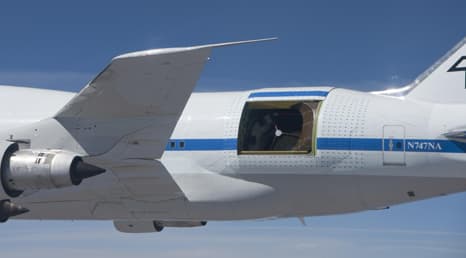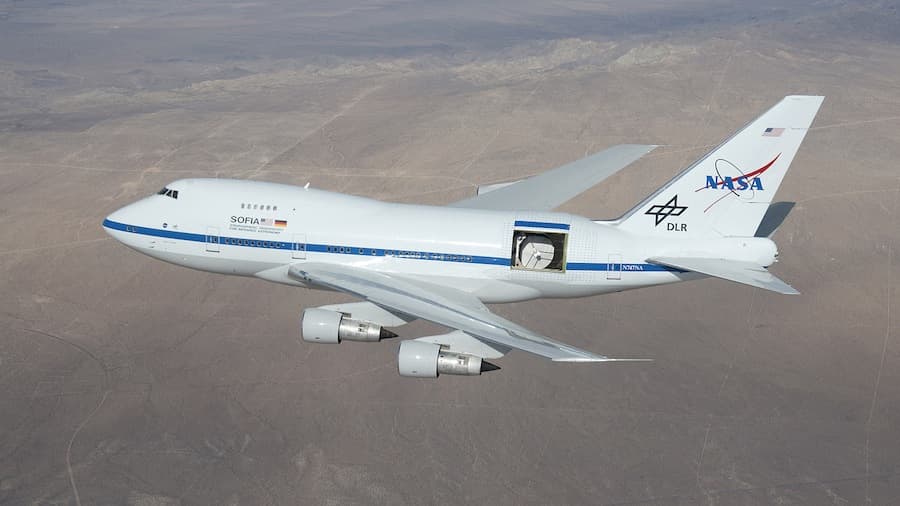Flying Observatory SOFIA To Begin Work Shortly
First came telephones, then came mobile phones. Similarly, first came the giant warehouse-size computers and now (thankfully), we have slim and light laptops. For us humans, anything is better when it can be carried around. NASA and German Aerospace Centre (DLR) probably got hooked on to this concept and constructed the Stratospheric Observatory For Infrared Astronomy (SOFIA), a 17-tonne observatory mounted on a modified Boeing 747SP. SOFIA is currently undergoing modifications and overhaul at Hamburg after it had formally completed all the development works on May 29, 2014. It is expected to be operational by 2015.

The Plane:
The carrier for the telescope is a Boeing 747SP (S-Special, P-Purpose) which was first brought into service in 1977. Pan Am Airlines and then United Airlines operated it until it was sold to NASA. NASA chose the German carrier Lufthansa Technik for maintenance since now Boeing itself does not offer support for this aircraft. The aircraft has a shorter fuselage enabling it to fly at an altitude of 12-14 Km, higher than normal commercial aircraft. At such high altitude, IR radiations can be studied which is not possible on ground observatories since water vapour blocks most of the infrared waves. Special modifications were made - modified cockpit electronics, very extensive additional electronic systems and perhaps the trademark of this unique aircraft- a 4-by-6 meter door in the fuselage which opens when the telescope is in operation.

The Gadgets:
The 2.5 meter infrared reflector telescope on this aircraft has an oversized 2.7 meter diameter primary mirror. The scientific instruments currently aboard the plane are: FLITECAM, a near infrared camera covering 1–5 micrometres; FORCAST, covering the mid-infrared range of 5–40 micrometres, and HAWC, which spans the far infrared in the range 42–210 micrometres, FIFI-LS (Field-Imaging Far-Infrared Line Spectrometer) and the GREAT spectrometer. These will be used to study the development of galaxies and how stars and planetary systems are formed from molecular and dust clouds.

The instruments aboard SOFIA
The Future:
The German SOFIA Institute (DSI) at the University of Stuttgart will help in the maintenance of the telescope. After the Hamburg overhaul, SOFIA will be resuming operations in 2015 with approximately 100 planned observation flights per year. The astronomy community will hope that the SOFIA, a truly unique tool, will serve them well in years to come.
Got you interested? Check out NASA's Kuiper Airborne Observatory.
Source: #-Link-Snipped-#

The carrier for the telescope is a Boeing 747SP (S-Special, P-Purpose) which was first brought into service in 1977. Pan Am Airlines and then United Airlines operated it until it was sold to NASA. NASA chose the German carrier Lufthansa Technik for maintenance since now Boeing itself does not offer support for this aircraft. The aircraft has a shorter fuselage enabling it to fly at an altitude of 12-14 Km, higher than normal commercial aircraft. At such high altitude, IR radiations can be studied which is not possible on ground observatories since water vapour blocks most of the infrared waves. Special modifications were made - modified cockpit electronics, very extensive additional electronic systems and perhaps the trademark of this unique aircraft- a 4-by-6 meter door in the fuselage which opens when the telescope is in operation.

The 2.5 meter infrared reflector telescope on this aircraft has an oversized 2.7 meter diameter primary mirror. The scientific instruments currently aboard the plane are: FLITECAM, a near infrared camera covering 1–5 micrometres; FORCAST, covering the mid-infrared range of 5–40 micrometres, and HAWC, which spans the far infrared in the range 42–210 micrometres, FIFI-LS (Field-Imaging Far-Infrared Line Spectrometer) and the GREAT spectrometer. These will be used to study the development of galaxies and how stars and planetary systems are formed from molecular and dust clouds.

The instruments aboard SOFIA
The Future:
The German SOFIA Institute (DSI) at the University of Stuttgart will help in the maintenance of the telescope. After the Hamburg overhaul, SOFIA will be resuming operations in 2015 with approximately 100 planned observation flights per year. The astronomy community will hope that the SOFIA, a truly unique tool, will serve them well in years to come.
Got you interested? Check out NASA's Kuiper Airborne Observatory.
Source: #-Link-Snipped-#
Replies
You are reading an archived discussion.
Related Posts
CodeMyMobile was founded in 2013 with a vision to harness the power of brilliant minds to solve complex technology problems and deliver outstanding customer satisfaction. It is a privately held...
can u suggest me d good colleges nd univs. for persuing mtech in structures abroad
Intrinsic and Extrinsic Semiconductors
Intrinsic Semiconductors:
1. Semiconductors material in extremely pure form is called intrinsic semiconductor.
2. Free electrons and holes are generated in pairs. Thus concentration of holes...
NASA is planning to use Google's 3D mapping technology for its SPHERES project. SPHERES which stands for Synchronized Position Hold, Engage, Reorient, Experimental Satellites was deployed by NASA in 2006...
I am not able to access google drive since many days, is it working for you or it's just me?
